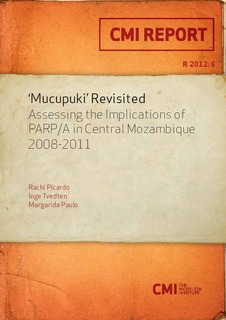| dc.contributor.author | Picardo, Rachi | |
| dc.contributor.author | Tvedten, Inge | |
| dc.contributor.author | Paulo, Margarida | |
| dc.date.accessioned | 2018-01-04T08:17:53Z | |
| dc.date.available | 2018-01-04T08:17:53Z | |
| dc.date.issued | 2012-01-01 | |
| dc.identifier | oai:www.cmi.no:4757 | |
| dc.identifier.citation | Bergen: Chr. Michelsen Institute (CMI Report R 2012:6) 58 p. | |
| dc.identifier.isbn | 978-82-8062-464-2 | |
| dc.identifier.issn | 0805-505X | |
| dc.identifier.uri | http://hdl.handle.net/11250/2474806 | |
| dc.description.abstract | This is the final report in a series of six studies to monitor and evaluate Mozambique’s Poverty Reduction Strategies PARP/A (2006-2012). The series focuses on three different areas in the country, including the District of Buzi in the central province of Sofala. Despite severe structural political and economic constraints, people in Buzi have seen small improvements in their socio-economic conditions between 2008 and 2011. In addition to their own hard work, the proximity to the city of Beira is a major reason for the advances made. Rather than counting on economic growth to ‘trickle down’, the government should remove constraints related to agriculture and income and facilitate rural-urban interaction. | |
| dc.language.iso | eng | |
| dc.publisher | Chr. Michelsen Institute | |
| dc.relation | CMI Report | |
| dc.relation | R 2012:6 | |
| dc.relation.ispartof | CMI Report | |
| dc.relation.ispartofseries | CMI Report R 2012:6 | |
| dc.relation.uri | https://www.cmi.no/publications/4757-mucupuki-revisited | |
| dc.subject | Poverty | |
| dc.subject | Evaluation | |
| dc.subject | Mozambique | |
| dc.title | 'Mucupuki' Revisited: Assessing the Implications of PARP/A in Central Mozambique 2008-2011 | |
| dc.type | Research report | |
